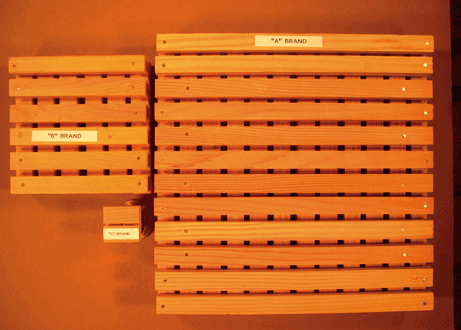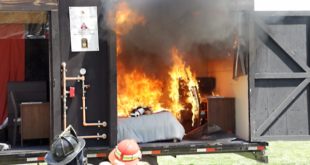
Ratings, Fire Testing and Standards – Part Three
Are you tired of testing yet?
I hope not, because continued testing of materials and assemblies is absolutely critical to fire safety engineering. The future calls for more and more precise use of test data to support decisions that we make for approving installations. And our ability to understand the strength and weaknesses of the various systems used to describe products is going to be part of our professional lexicon for some time to come.
As a fire prevention regulator or code enforcer, you are going to see more and more test results in the future, not less. For example, let’s says your department is in an area where there is a wildland-urban interface problem. What does that mean about what you need to know about roof materials and testing? Is a Class A roof the same as a Class 1 roof? Unfortunately not. How can we tell the difference?
Standard Test Methods for Fire Tests of Roof Coverings
UL 790 When we talk about fire safety and roofing most people only think of a fire involving roofs exposed to firebrands and ember showers. UL 790 covers the requirements for the fire resistance performance of roof coverings exposed to simulated fire sources originating from outside a building on which the coverings are installed. Think Urban-Wildland scenarios… or even large-conflagration fires in densely built-out cities. But, it is not the same as Class 1 roof. But, it is not the only way to look at roof assemblies.
UL 790 is designed to measure the relative fire characteristics of roof coverings exposed to simulated fire sources originating from outside of a building on which the covering has been installed. It is intended for installation on either combustible or noncombustible decks when the roof coverings are applied as intended. Testing to this standard results in a material being able to resist one of three classes of fire exposure. They are: Class A, Class B, and Class C.
Class A roof coverings are effective against severe fire test exposures. Under such exposures, roof coverings of this class afford a high degree of fire protection to the roof deck, do not slip from position, and are not expected to produce flying brands.
Class B roof coverings are effective against moderate fire test exposures. Under such exposures, roof coverings of this class afford a moderate degree of fire protection to the roof deck, do not slip from position, and are not expected to produce flying brands.
Class C roof coverings are effective against light fire test exposures. Under such exposures, roof coverings of this class afford a light degree of fire protection to the roof deck, do not slip from position, and are not expected to produce flying brands.
When Class A roof coverings are effective against severe fire test exposures, they may or may not prevent the building from igniting. I have personally seen hundreds of Class A roofs lying atop rubble when fire gets into the attic space or the interior of the structure.
These fire test methods do not provide a basis to compare expected performance under all actual fire conditions, but they do provide a basis for comparison of the response of roof coverings when subjected to fire sources that are described herein.
The test to determine this level of safety is generically called “the burning brand” test, and it uses the three different test modules to determine the classification. You will note that there are three different sizes of “brands” that are being used to determine the resistance to fire from the outside. In my career I have seen brands flying through the air that can meet any of these size comparisons.
For additional information on this concept see: youtube.com/watch?v=HII6Tahfj8M
But, what about that other classification of a Class 1 roof?
A Class 1 roof is a deck assembly that must not only resist fire from an external source, but from an internal source as well. In addition it must address issues of wind uplift resistance, foot traffic on its surface, corrosion resistance, impact resistance, and susceptibility to heat exposure.
What this boils down to is that a Class 1 can be substituted on a building for a Class A, Class B, or a Class C. But, a Class A, B or C cannot be substituted for a Class 1.
For additional information on this concept, see: rci-online.org/interface/2006-02-blum.pdf
Summary
So, in the final analysis, a roof is a roof, is a roof. Or at least that is what Gertrude Stein might say. But you as a fire prevention professional will know that they aren’t all the same. Some are better at resisting external forces. Others are better at resisting internal forces. And lastly, every one of them has a place in the panoply of options for builders and developers to use. The next step in your conquering the differences is to note that all of them MUST be installed as they are tested if they are going to do the job. And, lastly, they will all perform differently in the real world during a fire. This is not a new body of knowledge. As early as the rebuilding of London in the aftermath of the great London fire September 2, 1666, there was concern over roof construction.
The battle to prevent roofs from being a bigger part of the problem is far from over. See: luminarium.org/encyclopedia/greatfire.htm and iafss.org/publications/frn/369/-1/view.
REFERENCES: 1. Schofield, John. The Building of London: From the Conquest to the Great Fire. British Museum. London 1984.
 ABOUT THE AUTHOR: Ronny J. Coleman is currently the president of Fireforceone. He is a past president of the IAFC and CFAI. Over his lifetime, he has received numerous awards including the AFSA’s 1989 Henry S. Parmelee Award, the 2011 Mason Lankford Award from the Congressional Fire Services Institute, and the Tom Brennan Lifetime Achievement Award from Fire Engineering in 2014. He continues as a contributor to the fire service in many ways.
ABOUT THE AUTHOR: Ronny J. Coleman is currently the president of Fireforceone. He is a past president of the IAFC and CFAI. Over his lifetime, he has received numerous awards including the AFSA’s 1989 Henry S. Parmelee Award, the 2011 Mason Lankford Award from the Congressional Fire Services Institute, and the Tom Brennan Lifetime Achievement Award from Fire Engineering in 2014. He continues as a contributor to the fire service in many ways.
EDITOR’S NOTE: This six-part series will be continued in future issues of Sprinkler Age. Part 1 and Part 2 appeared in the April 2015 and June 2015 issues, respectively.

 Sprinkler Age A Publication of the American Fire Sprinkler Association
Sprinkler Age A Publication of the American Fire Sprinkler Association
